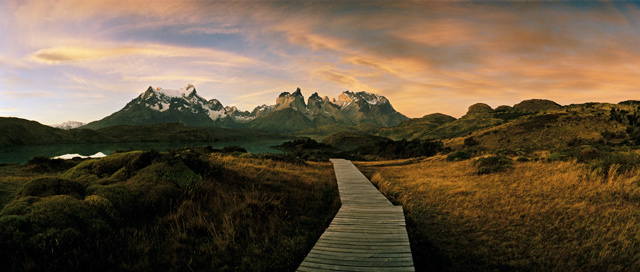
When Santa Barbarans hear the name Patagonia, most think of the famous adventure-clothing company headquartered just south of here. But Yvon Chouinard named his company deliberately for the tough, beautiful territory that straddles Chile and Argentina at the toe of South America.
With a landscape that mirrors the Northwest of the United States and a paean to outdoor adventure, Patagonia has lured many a Santa Barbaran for a visit. Filmmaker and former professional surfer Chris Malloy captured Patagonia’s essence in his 2010 documentary 180 Degrees South. And artistic power duo renowned photographer Macduff Everton and artist/writer Mary Heebner have traveled there many times during the past two decades capturing the remote land in pictures and paintings, which they recently bound together in their latest book collaboration, Patagonia: La Última Esperanza.
“Situated at the ends of the earth, vast and mostly uninhabited, with limitless horizons, it is a land of lost boundaries,” writes Heebner of the territory that comprises more than one million square kilometers. For this work, Heebner and Everton train their artistic visions on just one of Patagonia’s realms, the Última Esperanza (“Last Hope”) Province in the Chilean region of Magallanes and Antártica Chilena. With stunning panoramic photographs, Everton succeeds brilliantly in characterizing the wild landscape that defines Patagonia; through her words and drawings, Heebner evokes the domain’s history, adventure, and poetry.
The gorgeously printed book is organized in sections, each focusing on a theme or location. For example, “Puerto Natales” depicts the province’s capital, established in 1911 on the shore of Last Hope Sound; “Architecture in Patagonia” reveals designs employed on newer buildings in the area that “spearhead the fusion of shelter and landscape,” such as Hotel Remota and Hotel Salto Chico. “Sierra de los Baguales” (“Range of Wild Horses”) is where the authors spent six hours on horseback exploring the mountains that divide Chile and Argentina; and “Torres del Paine” (“Towers of Blue”), established in 1978 as a biosphere reserve by UNESCO, is, according to Heebner, “one of the most remote and unspoiled places on the planet.”
Patagonia offers an awe-inspiring peek into the Province of Last Hope, which, as Heebner writes and the book so beautifully illustrates, “has grown out of [a] conglomerate of hope, despair, and steely endurance.”
4•1•1
Patagonia: La Última Esperanza is available at area bookstores.



